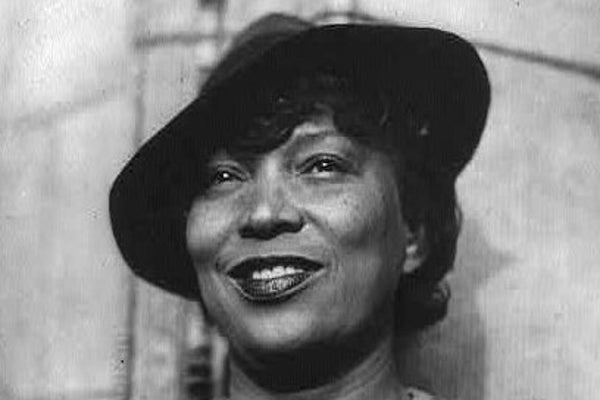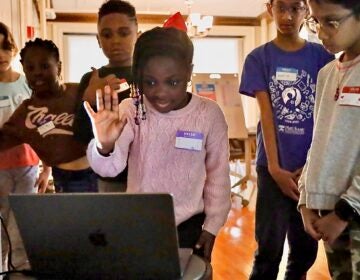Novelist Zora Neale Hurston was a cultural anthropologist first
Listen 9:55
Before she was a novelist, Zora Neale Hurston was a cultural anthropologist. (Photo via Library of Congress)
The celebrated novel ‘Their Eyes Were Watching God’ grew from fieldwork in the Black South.
Before novelist Zora Neale Hurston shook up the fiction-writing world with her 1937 classic “Their Eyes Were Watching God,” she was doing things her way in the field of anthropology.
Hurston collected songs and folklore in Florida and Louisiana, where she embedded herself in the black communities as a participant, not just an objective observer.
Early life
Hurston was likely born in 1891 but throughout her life, she told tall tales about her age—especially in early life, she fibbed to expand her opportunities, get an education and stay in school for as long as possible.
She and her seven siblings lived in Eatonville, Florida, an all-black town outside of Orlando. They lived on five acres with citrus trees and chickens where young Hurston had time to play and think.
The only white people in Eatonville were visitors, and later Hurston wrote that, often, she sat on the front porch watching them pass by.
The porch was her gallery seat, and on her boldest days, Hurston would hop down and ask the white passersby where they were headed. You can almost see young Zora, a budding anthropologist, starting to find her passion.
A smart, precocious child, who so easily stepped over the color line, Hurston’s boldness must have frightened her family and neighbors. But she later writes that she was “their Hurston, nevertheless.”
A young writer
Somewhere between five and 10 years later, Hurston moved to Baltimore. She got a job and took night classes, then enrolled in high school. She was 27 by the time she earned her diploma–an age when most women would be marrying or settling down.
For a black woman in 1918, raised with Jim Crow laws and segregation, finishing high school was a big deal. But Hurston wasn’t done yet.
She became a part-time student at Howard University, a historically black college in Washington, D.C. She went to class in the morning, worked at a barbershop in the afternoon, and studied at night. One of her short stories got published: It was about a young black girl who was filled with this boundless sense of joy—and that focus on black joy was pretty unusual in 1920s literature.
Later Hurston became part of the Great Migration north. When she stepped off the bus, she had less than $2 in her pocket, but she was a published author. She worked as a secretary and by fall 1925, she earned a scholarship to Barnard, where she studied anthropology.
In her research, Hurston documented exactly what she heard. The dialogue was packed with slurs and one word ran right into the next one—and that drew criticism from some black elites.
W.E.B. Du Bois says they way Hurston wrote language made black people sound primitive—in his estimation–not a great image for black people looking to improve their standing in society.

Culture collector
At Columbia University’s anthropology department, Hurston worked with Franz Boas, sometimes called the Father of American Anthropology. He was pushing his students to place themselves in the center of what they study. It wasn’t a big stretch for Hurston, who’s been aiming to do that all along.
Her first serious fieldwork expedition was back home, in rural Florida. But she had changed since she last lived there, and it wasn’t all that easy to slide back in.
She wore a nice dress and drove a car that she calls “Sassy Susie.” Hurston later said she was speaking in “carefully accented Barnardese.” She joked that she was asking, “‘Pardon me, but do you know any folk-tales or folk-songs?'”
She failed to embed herself, and as a result, people didn’t want to share their stories.
The stories she collected disappointed her. So Hurston headed back to New York, and there she found a new fan, Charlotte Osgood Mason, a wealthy socialite and philanthropist. The artists she supported called her “Mrs. Mason.”
Mrs. Mason’s money came with strings attached: the patron got to decide how and when Hurston’s folklore made it to the public. Mrs. Mason expected the black people in Hurston’s writing to have a cloying sincerity in the way that they lived and behaved.
But with the new funding, Hurston headed south to Eatonville, Florida again. This time, she had more success. She went to parties and made friends with a lady named Big Sweet who showed her the best storytellers. Big Sweet also kept Hurston out of trouble. She put herself right in the middle of the community and this time, she collected first-rate folklore.
After that, Hurston expanded her research to New Orleans to study spiritual practices like hoodoo and voodoo. To earn the devotees’ trust and respect she went without food for days and laid naked near an altar for 69 hours, learning how to communicate with spirits. Hurston didn’t only feel respect; she felt a sense of urgency to collect the history of voodoo–as she put it–before white folks ruined it.
Hurston’s fieldwork became 100 pages of research in the 1931 “Journal of American Folklore.” Then she signed a deal for her ethnography “Mules and Men,” a book of Hurston’s detailed, first-hand research, infused with her reflections. The book read like a collection of short stories, but it’s anthropology.
Soon after, Hurston lost interest in the formalities of academic research. She pursued and then dropped out of a Ph.D. program, and applied for other funding.
In 1936, Hurston won a Guggenheim fellowship to study magic in Jamaica and Haiti–more voodoo. Hurston embedded herself again and learned about vegetable poisons and antidotes. She went on a wild boar hunt, and wrote that she went there when a chief medicine man silenced every frog in the jungle with his mind.
Working in Haiti coaxed out Hurston’s most famous novel, “Their Eyes Were Watching God.” She returned home to publish it, and after that, more or less settled in the south. She worked with the Federal Writers Project next, collecting more stories.
Hurston continued to write until her death in 1960, although she had to take other jobs–even if she lived modestly–writing wasn’t enough to support her.
There are people who might question if Hurston was indeed a scientist. But what makes a scientist anyway?
Hurston started on her porch in Eatonville making observations–one of a scientist’s most important tasks. She published her research in anthropology journals. Plus, Hurston’s books were her way of reporting tales of black life. She picked a medium that would speak to masses of people. So, she’s decades ahead of open-source science.
She also stood up to peer review; Hurston definitely had her critics. One of her popular critiques was that something was missing from her accounts of black life. Critics couldn’t find the misery, the bitterness, the smoldering resentment of black people, and they wanted to know why Hurston’s characters were so carefree.
Maybe Hurston already saw that perspective. Others had documented it, meticulously. Hurston instead uncovered other parts of black life. She wanted to increase the sample size.
Maybe the best evidence that Zora Neale Hurston was a scientist comes from her, she said: “Research is formalized curiosity. It is poking and prying with a purpose.”
Poncie Rutsch is the creator of the podcast Babes of Science and a radio producer at The Big Listen in Washington, D.C.
WHYY is your source for fact-based, in-depth journalism and information. As a nonprofit organization, we rely on financial support from readers like you. Please give today.






